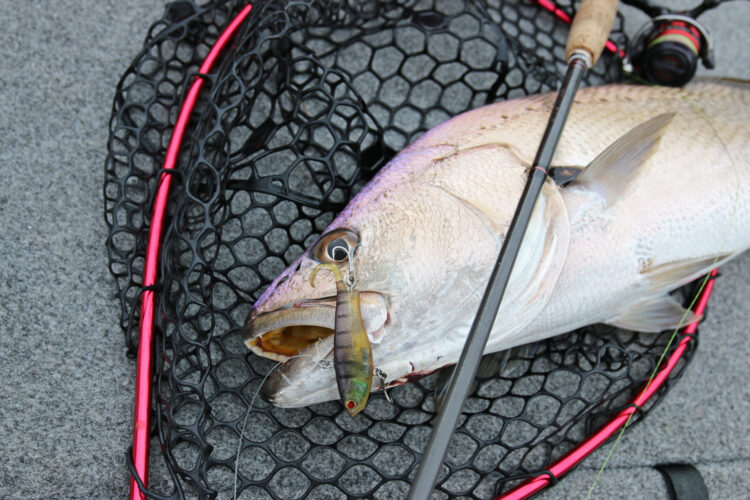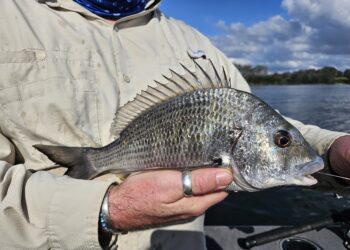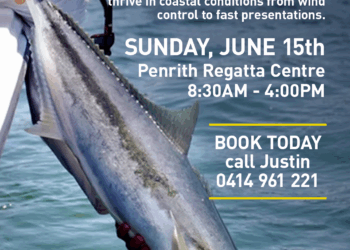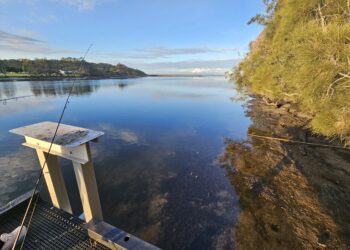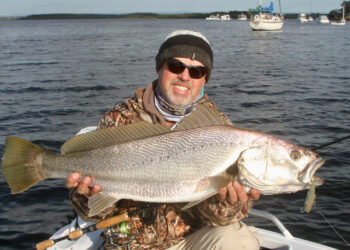DESPITE being regarded as the “Dry Continent” numerous waterways line Australia’s east coast. Rivers, estuaries, and salty lagoons are common and attract many fishermen. Most are tidal, rich in aquatic life, and support populations of fish anglers want to catch.
Bream, whiting, flathead, jewfish, flounder and tailor are popular targets. In southern waters, anglers will encounter more salmon while further north, perhaps from Port Macquarie up, we see more trevally and jacks. Regardless of where you fish there will be a variety of species to target. These waters lend themselves to a range of lure types and techniques that are fun to use and challenge our skills.
In this article we look at some effective ways to lure your local waterway.

Jigging Micro Blades
The “Micro Blade” is a small metal lure fitted with size 8 – 12 assist hooks. It looks a little like a crab or prawn. These little blades catch just about everything.
One of the most popular and effective is the Ecogear VX Blade. Many other brands also make metal blades in the 35-50mm range that weigh between 3.5 and 10gm. They come in a variety of colours including dark brown, chrome and natural tones. Some feature holographic finishes. This allows you to match the food local fish are feeding on. Browns and black for crabs and lighter colours for prawns and small fish.
To fish these lures, choose a light two to four kilo threadline outfit. Fish them on a light trace to achieve the best action. The downside is that tailor and flatties can snip a few off.
Look for bait schools in water two to six metres deep. As this is a light approach avoid areas with strong tidal runs except during the tide change. These lures are best worked on the bottom and will catch a wide variety of species. Lower them until the line goes slack then simply lift and feel the lure vibrate. Repeat this until you feel a tug, and thanks to those needle sharp little assist hooks, you are on.
On a recent trip using these fantastic little lures over rubble bottom and near bait schools, we caught school jew, trevally, bream, flathead and a flounder.

Jigging Soft Vibes
Soft vibes are a highly effective lure that can be used in both shallow and deep-water situations. They are designed to look mimic a struggling baitfish. Each brand has variations in construction, weight, tail configuration, colour range and size. Most models come in several weights with mid-range models in the 18-23gm range being the “go to” for many anglers. The smaller models are also worth using. Save the larger 28gm models for deep water.
The first soft vibe to gain widespread popularity was probably the Jackall Transam and these are still great options. There are nearly a dozen other brands that all come in a wide range of colours. I prefer natural hues in cleaner water and bright colours like lime green in discoloured water. As for most lures, a good smear of scent will increase their appeal.
These lures will find a snag or weed so if this is a problem it is better to go to a soft plastic on a jig head. A lure retriever will reduce losses significantly.
A four to six kg sized rod and reel in either spin or overhead will work these lures effectively. In shallow water cast out then let the lure settle on the bottom. To retrieve, lift, pause to let it sink, and repeat. The lure should vibrate as it is pulled off the bottom then flutter down. Flathead love these lures and attack them aggressively. Vary the speed, length and power of the lift and try letting them drop under control or on a slack line to find what the fish want.
In deep water vertical jigging is effective and we have taken jew, bream, grunter, flathead and trevally. Salmon love these lures too. In northern waters they also take barra, threadfin, golden snapper, queenfish and trevally.

Casting Small Surface Lures
When the prawns are present, anglers can enjoy excellent fishing using surface lures. Both small poppers and stick baits work. Ensure the model you select has enough weight (three grams or more) to cast long and is fitted with the sharpest trebles available. The Ecogear Sugarpen 70 is a popular version that works well on fish including whiting and bream.
A spin outfit in the two kg category is ideal. Light braid line and short 2-5kg trace is ideal. I use a longer rod (2.3m) to increase casting range. Spin reels in 1000-2500 size are perfect for this job.
Sand and mud flats are often good areas to work over. Weed beds are also productive. Bream, whiting and flathead are all viable targets in shallow water. Use long wind-assisted casts and retrieve steadily for whiting. Stop, start the retrieve for bream. In deeper areas, particularly where bait collects, anglers can use slightly larger lures and heavier rod to catch tailor, salmon, trevally and small kings.

Trolling Minnows (Shallow water)
Trolling small minnows or crankbaits is a highly effective method that will take bream, flathead, flounder and occasionally whiting. Good examples of effective lures include the Micro Mullet and the Zerek Tango Shad 50. There are a wide range of fat and long, slim lures that will also work well including the Jackall Chubby, Atomic Hardz 38 and the Daiwa Double Clutch. For flathead choose hard colours like hot pink and lime green or even black. For bream go for natural and clear tones. As for all lures, ensure trebles are sharp.
Light outfits in the two to four kg range are ideal. Braid mainline and a two to six kg trace is a good starting point, but you can go lighter particularly if bream are the target. Troll slowly and stagger lures back from the boat to avoid tangles.
This is an active method that can be great fun. Work over shallow flats and sand bars and while trolling works on any tide, running over flooded nipper beds around high tide is often productive. Putting rods in the holder will work but having each angler stand up and hold their rod will increase the strike rate. Make sure each angler is “working” the lure by gently surging it forward and then dropping back to add additional action. Watch for fish as you troll along. Those “mud puffs” are often flatties that are briefly startled as you pass by. These signs tell you the area holds fish and you should work it for several runs.

Casting and Trolling Metal Jigs and Spinners
In the lower parts of most systems pelagic predators such as tailor, kings, tuna and salmon will enter the estuary to feed on baitfish. Small splashes and diving terns and gulls will indicate that they are feeding high in the water. The later part of the run-in tide is often more productive.
These predators will often take a rapidly retrieved metal lure roughly the size of the bait they are feeding on. Chrome jigs, slices and even barrel sinkers painted white will work. Examples include the Gillies Baitfish, Halco Twisty, Samaki Flash and Lazer Lures. Carry them in 10-50gm sizes and different colours. Cast beyond the feeding frenzy, pause for a second or two then retrieve briskly.
A light spin outfit around four kg is all that is required although the need for speed and line capacity will make a 3-4000 sized spin reel with a high gear ratio an asset.
Between each “bust up” things may go quiet. By trolling the lures around the area anglers can take fish that otherwise might go unnoticed.

Deep Trolling Hardbodies
Many estuaries and rivers have deep tidal scoured sections or deeper holes. Along with rock bars and bridges these can be home to some highly desirable species. Some predators including big flatties, jacks, barra, cod, tailor and trevally love these areas but are quite difficult to target. Many will respond to a deep diving lure worked close to the bottom.
Deep trolling is quite challenging to master. Pulling bigger minnows in current is definitely hard work particularly when you add driving the boat and watching the sounder. Stuff ups are quite common, and snags can drive you crazy. A Tackle Back or similar lure retriever is a good investment.
Repeated runs along a pre-planned troll line with each lure bumping the bottom is a good technique. Suitable lures include a range of Aussie and overseas models. Lures in 90-130mm length with the capability to reach three to six metres are required.
Stronger gear in 6-8kg is needed to handle the pressure exerted by the lure. Heavier traces in eight to 15kg will also assist in surviving brushes with sharp reef.
Match the lure size to the predominant baitfish. I have used Predatek Boomerangs, Classics, RMG Scorpions, Manns Stretch 20s and Poltergeists. Atomic Double Deep, deep diving Bombers and similar are all useful.
Casting Small Crankbaits
Small cranks include minnows, fat bodied and slim longer lures in the 35-95mm length. There are numerous options on the market, and they are a fun way to take a variety of estuary species. Use the same gear outlined in “small surface”. Select lures that have enough weight to cast well. Carry a range that includes shallow, medium and deep divers.
Cranking works around structure such as rock walls, bridges, jetties and pontoons and along natural rocky edges and across flats. It also works around moored boats where fish sit in the shade from under the hull. By selecting an appropriate model that suits the depth you are fishing you can work much of an estuary or riverbank.
Flathead, bream and trevally are all keen to slam a crank. Beware of tailor and pike which can snip you off!

Slow and Micro Jigging
Slow and micro jigs are small metal lures that come in a variety of shapes and weights. They are designed to dart, shimmer and flash in a way the draws a strike. Weights range from 10-60gm and many are armed with one or more pairs of assist hooks.
Jigging near bait concentrations as the boat drifts over a deep hole or slot works well on flathead, jewfish and tailor. Working in tight next to structure is also effective with break and training walls well worth a drift.
Slow jig outfits are designed to “work” the lure by simply turning the reel and letting the rod tip bounce. Micro and not so small jigs rely more on the angler using rod action to make the lure move erratically.
True micro jigs are small lures that will tempt most fish. These also need to be worked near bait or on the bottom. They will take a wide range of fish including flathead, bream, jewfish and trevally.
Casting Soft Plastics
Many anglers are familiar with soft plastic fishing. There are an almost infinite variety of tails in every colour scheme imaginable. The key is to select a jig head that matches the tail and has the weight to get to the bottom. Many tails also work well fitted to a weightless or lightly weighted “G” Hook.
Tiny 50mm plastics in wriggler styles are always well received by bream and Estuary perch. Bigger models are popular for working the flats and drop offs while 150mm plus models are often chosen to entice big fish like oversized flathead to strike. Some tails come with scent or other additives that enhance their effectiveness.
Putting it together
We launched an hour before high tide. Dawn was just breaking as we motored across the river. A quick troll on a flat just down from the ramp produced three flathead and a flounder. As the tide slowed, we moved downstream to a deep hole and worked soft vibes and jigs down deep. We persevered through the tide change for one small flattie but just as we decided to give it away, Connor hooked and landed a nice jew that went 82cm. I missed one on a vibe soon after. By now the tide was running out hard.
A large sand flat provided an ideal area to work with surface lures and we caught several good-sized whiting and a few throwbacks. I lost a popper to a tailor and Connor hooked a flattie that jumped after it smashed his surface walker. We spent several hours fishing both surface and shallow running cranks for a modest bag of whiting and one 56cm flattie. On several weed clumps we also encountered bream which responded well to stop start retrieves. As we drifted across the flats, we threw some large plastic stick baits for big flatties but on this trip only got one half-hearted boil.
As we transitioned into the final part of the run out, we switched to deep divers and trolled a rock retaining wall for jacks. One pinnacle in seven metres of water revealed some big arches on the sounder which we targeted with deep diving minnows. One Moses perch and a missed strike later and with tide slowing we changed to soft vibes and drift jigged the area.
After the tide changed and fresh, clean seawater started to push upstream, we spent a few minutes down near the river entrance spinning for tailor that sporadically busted up along the channel drop off. They were smaller fish and several coughed-up whitebait.
We both caught over twenty fish each and I kept enough jew, flatties and whiting to provide fillets for a seafood dinner. Total fishing time seven hours and we were home for a late lunch.





